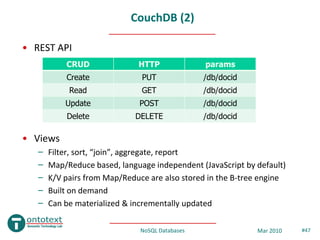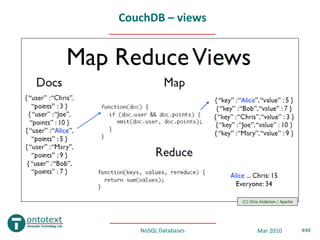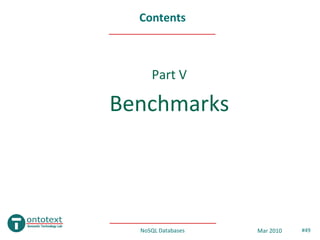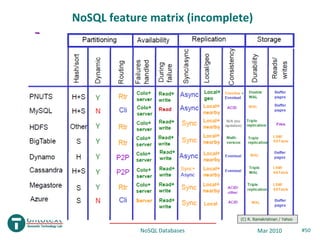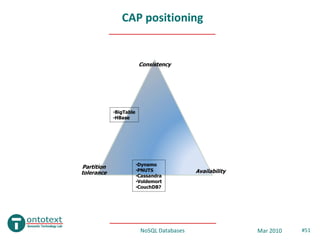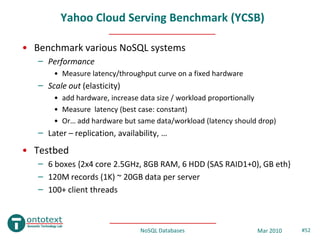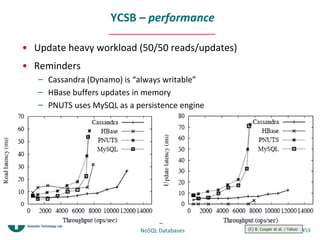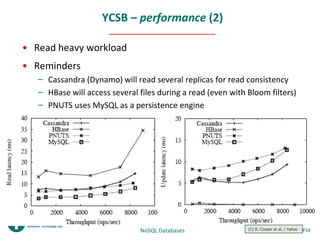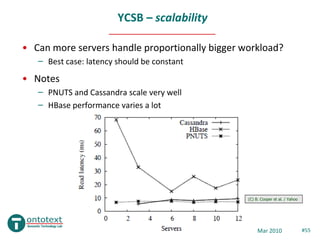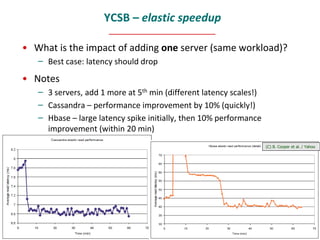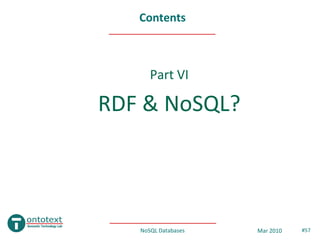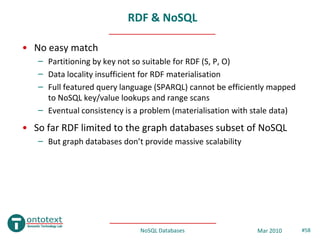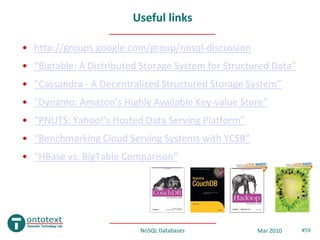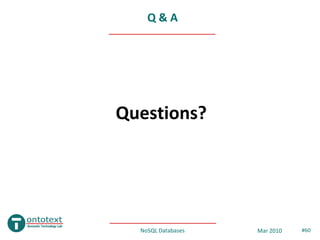NoSQL databases
- 1. NoSQL Databases technology watch #2 Mar 2010
- 2. Contents • Introduction • Key-Value stores • Column stores • Document stores • Graph Databases • Benchmarks • RDF & NoSQL NoSQL Databases Mar 2010 #2
- 3. Contents Part I Introduction NoSQL Databases Mar 2010 #3
- 4. Why NoSQL? • Is NoSQL equal to “SQL “or to “Not Only SQL”? • ACID doesn’t scale well • Web apps have different needs (than the apps that RDBMS were designed for) – Low and predictable response time (latency) – Scalability & elasticity (at low cost!) – High availability – Flexible schemas / semi-structured data – Geographic distribution (multiple datacenters) • Web apps can (usually) do without – Transactions / strong consistency / integrity – Complex queries NoSQL Databases Mar 2010 #4
- 5. Some NoSQL use cases 1. Massive data volumes – Massively distributed architecture required to store the data – Google, Amazon, Yahoo, Facebook – 10-100K servers 2. Extreme query workload – Impossible to efficiently do joins at that scale with an RDBMS 3. Schema evolution – Schema flexibility (migration) is not trivial at large scale – Schema changes can be gradually introduced with NoSQL NoSQL Databases Mar 2010 #5
- 6. NoSQL pros/cons • Advantages – Massive scalability – High availability – Lower cost (than competitive solutions at that scale) – (usually) predictable elasticity – Schema flexibility, sparse & semi-structured data • Disadvantages – Limited query capabilities (so far) – Eventual consistency is not intuitive to program for • Makes client applications more complicated – No standardizatrion • Portability might be an issue – Insufficient access control NoSQL Databases Mar 2010 #6
- 7. CAP theorem • Requirements to distributed systems – Consistency – the system is in a consistent state after an operation • All clients see the same data • Strong consistency (ACID) vs. eventual consistency (BASE) – Availability – the system is “always on”, no downtime • Node failure tolerance – all clients can find some available replica • software/hardware upgrade tolerance – Partition tolerance – the system continues to function even when split into disconnected subsets (by a network disruption) • Not only for reads, but writes as well! • CAP Theorem (E. Brewer, N. Lynch) – You can satisfy at most 2 out of the 3 requirements NoSQL Databases Mar 2010 #7
- 8. CAP (2) • CA – Single site clusters (easier to ensure all nodes are always in contact) – e.g. 2PC – When a partition occurs, the system blocks • CP – Some data may be inaccessible (availability sacrificed), but the rest is still consistent/accurate – e.g. sharded database • AP – System is still available under partitioning, but some of the data returned my be inaccurate – e.g. DNS, caches, Master/Slave replication – Need some conflict resolution strategy NoSQL Databases Mar 2010 #8
- 9. … and also CAE • CAE trade-off (Amazon?) – Cost-efficiency – High Availability – Elasticity • Pick any two (Cost, Availability, Elasticity) – Cost Efficiency • By over-provisioning you get HA and E – High Availability • Just make the client wait when the system is overloaded (CE and E) – Elasticity • If you can predict your workload, you can provide HA + CE by booking the resources in advance • Everyone wants HA, so the challenge is providing E in a CE way NoSQL Databases Mar 2010 #9
- 10. NoSQL taxonomy • Key-Value stores – Simple K/V lookups (DHT) • Column stores – Each key is associated with many attributes (columns) – NoSQL column stores are actually hybrid row/column stores • Different from “pure” relational column stores! • Document stores – Store semi-structured documents (JSON) – Map/Reduce based materialisation, sorting, aggregation, etc. • Graph databases – Not exactly NoSQL… • can’t satisfy the requirements for High Availability and Scalability/Elasticity very well NoSQL Databases Mar 2010 #10
- 11. Contents Part II Key-Value stores PNUTS, Dynamo, Voldemort NoSQL Databases Mar 2010 #11
- 12. PNUTS • Yahoo, ~2008, part of the Y! Sherpa platform • Requirements – Scale out / elasticity – Geo-replication – High availability / Fault tolerance – Relaxed consistency • Simplified relational data model – Flexible schema – No Referential Integrity – No joins, aggregation, etc – Updates/deletes only by Primary Key – “Multiget” (retrieve many records by PKs) NoSQL Databases Mar 2010 #12
- 13. PNUTS – consistency model • Timeline consistency – In-between serializability and eventual consistency • All replicas apply updates for a record in the same order • but not necessarily at the same time (eventually) – One replica is always chosen as a Master (per record!) • adaptively changed for load re-balancing (usage pattern tracking!) • updates go only to the Master, then async propagation to other replicas / reads go to replicas or Master – Read consistency levels • Read any – may return a stale version of a record (any replica, fast) • Read critical (V) – return a newer (or the same) record version than V • Read latest – most recent version (goes to Master, slow) – Write consistency levels • Write • Test-and-set (V) – write only if the record version is the same as V (ensures serialization) NoSQL Databases Mar 2010 #13
- 14. PNUTS – consistency model (2) (C) Yahoo! NoSQL Databases Mar 2010 #14
- 15. PNUTS - architecture • Regions – (usually) geographically distributed replicas (20+ datacenters) – Pub/Sub asynchronous replication (Tribble) • Tablets – Horizontal partitioning of the tables (keyspace) – One copy of a Tablet within each Region • Components – Routers • Cached copy of the interval mapping for tablets – Storage Units (SU) • Filesystem or MySQL – Tablet Controllers (TC) • Maintains interval mapping, tablet split, load re-balancing, etc NoSQL Databases Mar 2010 #15
- 16. PNUTS – architecture (2) (C) Yahoo! NoSQL Databases Mar 2010 #16
- 17. PNUTS – architecture (3) • Message Broker – Pub/Sub replication – Notification service (even for external apps) – Reliable logging – 1 broker per tablet, but subscriptions on the table level possible too • “Mastership” – Record master – updates, “read latest” – Tablet master – inserts & deletes • Query processing – Replica – “read any”, “read critical” – Master – updates, “read latest” – Scatter/Gather engine – range queries, table scans, multi-record updates NoSQL Databases Mar 2010 #17
- 18. Dynamo • Amazon, ~2007 • P2P key-value store – Object versioning – Consistent hashing – Gossip – membership & failure detection – Quorum reads • Requirements & assumptions – Simple query model (unique keys, blobs, no schema, no multi-access) – Scale out (elasticity) – Eventual consistency (improved availability) – Decentralized & symmetric (P2P), heterogeneous (load distribution) – Low latency / high throughput – Internal service (no security model) NoSQL Databases Mar 2010 #18
- 19. Dynamo - partitioning • Consistent hashing – “Ring” of nodes (random position assigned to nodes when joining) – Node leaving/joining the ring affects only its 2 neighbours – Virtual nodes (improves the load balancing) – node is assigned several positions in the ring • Replication – N replicas (successor nodes on ring) • Versioning – All updates provide version context – Eventual consistency – Conflict reconciliation by clients (vector clocks) – Vector clock size thresholds (truncation) NoSQL Databases Mar 2010 #19 (C) Amazon
- 20. Dynamo – operations • Read/Write requests – Client sends a request to a random node, the node forwards it to the proper node (1st replica responsible for that partition – coordinator) – Coordinator will forward R/W requests to top N replicas • Consistency – Quorum protocol • R, W – minimum number of nodes that must participate in a Read/ Write operation (R+W > N) – Writes • Coordinator generates the version and the vector clock • Coordinator sends requests to N replicas, if W replicas confirm then OK – Reads • Coordinator sends requests to N replicas, if R replicas respond then OK • If different versions are returned then reconcile and write back the reconciled version (read repair) NoSQL Databases Mar 2010 #20
- 21. Dynamo – failure handling • “Hinted handoff” – Dynamo is “always writable” – If a replica node NR is down, the coordinator sends the write data to a new node NHH (with a hint that NR was the intended recipient) – Hinted writes are not readable, i.e. read quorum may still fail! – NHH will keep the data until NR is available again, then send the data version to NR and delete the local copy • “Anti-entropy” replica synchronisation – What if a hinted replica NHH fails before it can sync with NR? – Merkle trees • Pros – minimum data transfer (only the root node hash compared when in-sync), very fast location of out-of-sync keys (tree traversal) • Cons – trees need to be re-calculated when nodes join/leave the ring (keyspace partitioning changes) NoSQL Databases Mar 2010 #21
- 22. Dynamo – architecture • Bootstrapping & node removal – New node gets a position in the ring – Several re-balancing strategies • Partition split - the node responsible for that keyspace partition splits it and sends half the data to the new node • Fixed size partitions – one or more partitions are sent to the new node – Similar process when a node leaves the ring • Node components – Request handling & coordination – Membership & failure detection – Local persistence engine • MySQL • BerkleyDB • In-memory buffer + persistence NoSQL Databases Mar 2010 #22
- 23. Voldemort • http://project-voldemort.com/ • Distributed key-value store – Based on Dynamo • Originally developed by LinkedIn, now open source • Features – Simple data model (no joins or complex queries, no RI, …) – P2P – Scale-out / elastic • Consistent hashing of keyspace • Fixed partitions (no splits, but owner may change when re-balancing) – Eventual consistency / High Availability – Replication – Failure handling NoSQL Databases Mar 2010 #23
- 24. Voldemort & Dynamo • Similar to Dynamo – Consistent hashing – Versions & Vector clocks -> eventual consistency – R/W quorum (R+W>N) – Hinted handoff (failure handling) – Pluggable persistence engines • MySQL, BerkeleyDB, in-memory NoSQL Databases Mar 2010 #24
- 25. Contents Part III Column stores BigTable, HBase, Cassandra NoSQL Databases Mar 2010 #25
- 26. BigTable • Google, ~2006 • Sparse, distributed, persistent multidimensional sorted map • (row, column, timestamp) dimensions, value is string • Key features – Hybrid row/column store – Single master (stand-by replica) – Versioning – Compression (C) Google NoSQL Databases Mar 2010 #26
- 27. BigTable - data model • Row – Keys are arbitrary strings – Data is sorted by row key • Tablet – Row range is dynamically partitioned into tablets (sequence of rows) – Range scans are very efficient – Row keys should be chosen to improve locality of data access • Column, Column Family – Column keys are arbitrary strings, unlimited number of columns – Column keys can be grouped into families – Data in a CF is stored and compressed together (Locality Groups) – Access control on the CF level NoSQL Databases Mar 2010 #27
- 28. BigTable - data model (2) • Timestamps – Each cell has multiple versions – Can be manually assigned • Versioning – Automated garbage collection • Retain last N versions • Retain versions newer than TS • Architecture – Data stored on GFS – Relies on Chubby (distributed lock service, Paxos) – 1 Master server – thousands of Tablet servers NoSQL Databases Mar 2010 #28
- 29. BigTable - architecture • Master server – Assign tablets to Tablet Servers – Balance TS load – Garbage collection – Schema management – Client data does not move through the MS (directly through TS) – Tablet location not handled by MS • Tablet server (many) – thousands of tablets per TS – Manages Read / Write / Split of its tablets NoSQL Databases Mar 2010 #29
- 30. BigData - workflow • Tablet location – B+ tree index – root (Chubby file) - location of the Root Metadata tablet – 1st level (Root Metadata tablet) – locations of all Metadata tablets – 2nd level (Metadata tablet) – location of a set of tablets • Each row is SSTable ID + end row ID – Clients cache tablet locations (C) Google NoSQL Databases Mar 2010 #30
- 31. BigData – workflow (2) • Tablet access – SSTable – persistent, ordered immutable map from keys to values • Contains a sequence of blocks + block index • Compression at block level • 2 phase compression, 10:1 ratio (standard gzip up to 3:1) – Updates • 1st added to the redo log • Then to the in-memory buffer (memtable) • If memtable is full, then it is flushed into a new SSTable and emptied – Reads • Executed over the merged memtable and all SSTables (Bloom filters) • Merged view is very efficient (data is already sorted) • Bloom filters – probabilistic maps on whether a specific SSTable contains a specific cell (row, column), i.e. disk lookups are drastically reduced NoSQL Databases Mar 2010 #31
- 32. BigData – workflow (3) (C) Google NoSQL Databases Mar 2010 #32
- 33. BigData – workflow (4) • SSTable compactions – Minor compaction • Memtable flushed on disk into a new SSTable and emptied • When: memtable is full – Merging compaction • Merge the memtable and several SSTables into 1+ new SSTable(s) • Then, empty the memtable and delete the input SSTables • New SSTable(s) can still contain deletion info + deleted data (no purging) • When: number of SSTables limit reached – Major compaction • A merging compaction with exactly 1 output SSTable and all deleted data purged • When: regularly (background) NoSQL Databases Mar 2010 #33
- 34. BigTable - performance • Benchmark with 1, 50, 250 and 500 Tablet Servers (C) Google NoSQL Databases Mar 2010 #34
- 35. BigTable, real world data volumes (ca. 2006) (C) Google NoSQL Databases Mar 2010 #35
- 36. HBase • http://hadoop.apache.org/hbase • Developed by Powerset, now Apache • Based on BigTable – HDFS (GFS), ZooKeeper (Chubby) – Master Node (Master Server), Region Servers (Tablet Servers) – HStore (tablet), memcache (memtable), MapFile (SSTable) • Features – Data is stored sorted (no real indexes) – Automatic partitioning – Automatic re-balancing / re-partitioning – Fault tolerance (HDFS, 3 replicas) NoSQL Databases Mar 2010 #36
- 37. HBase - architecture (C) Tom White NoSQL Databases Mar 2010 #37
- 38. HBase - operations • Workflow – Hstore/tablet location (== BigTable) • clients talk to ZooKeeper • root metadata, metadata tables, client side caching, etc – Writes (== BigTable) • First added to the commit log, then to the memcache (memtable), eventually flushed to MapFile (SSTable) – Reads (== BigTable) • First read from memcache, if info is incomplete then read the MapFiles – Compactions (== BigTable) • APIs – Thrift – REST • GET | PUT | POST | DELETE <table>/<row>/<column>:<qualifier>/<timestamp> NoSQL Databases Mar 2010 #38
- 39. HBase – MapReduce jobs • Can be a source/sink for M/R jobs in Hadoop (C) ??? NoSQL Databases Mar 2010 #39
- 40. HBase vs. BigTable • http://www.larsgeorge.com/2009/11/hbase-vs-bigtable- comparison.html Feature BigTable HBase Access control + - Master server single single/multiple* Locality groups + - Cell cache + - Commit logs (WAL) primary + secondary single Skip WAL for bulk loads ? yes Data isolation + - replication + In progress Everything else pretty much the same! NoSQL Databases Mar 2010 #40
- 41. Cassandra • http://cassandra.apache.org/ • Developed by Facebook (inbox), now Apache – Facebook now developing its own version again • Based on Google BigTable (data model) and Amazon Dynamo (partitioning & consistency) • P2P – Every node is aware of all other nodes in the cluster • Design goals – High availability – Eventual consistency (improves HA) – Incremental scalability / elasticity – Optimistic replication NoSQL Databases Mar 2010 #41
- 42. Cassandra – data model, partitioning • Data model – Same as BigTable – Super Columns (nested Columns) and Super Column Families – column order in a CF can be specified (name, time) • Cluster membership – Gossip – every nodes gossips to 1-3 other nodes about the state of the cluster (merge incoming info with its own) – Changes in the cluster (node in/out, failure) propagate quickly (LogN) – Probabilistic failure detection (sliding window, Exp(α) or Nor(μ,σ2)) • Dynamic partitioning – Consistent hashing – Ring of nodes – Nodes can be “moved” on the ring for load balancing NoSQL Databases Mar 2010 #42
- 43. Cassandra - operations • Writes (== BigTable… almost) – Client sends request to a random node, the node determines the actual node responsible for storing the data (cluster awareness) – Data replicated to N nodes (config) – Data first added to the commit log, then to the memtable, eventually flushed to SSTable • Reads (== BigTable… almost) – Send request to a random node, which forwards it to all the N nodes having the data • Single read – return first response / Quorum read – value that the majority of nodes agrees on – First read from memtable, if info is incomplete then read the SSTables – Bloom filters for efficient SSTable lookups • Compactions (== BigTable) Databases NoSQL Mar 2010 #43
- 44. Cassandra @ Facebook • Inbox search • ca. 2009 - 50 TB data, 150 nodes, 2 datacenters • Performance (production) (C) facebook NoSQL Databases Mar 2010 #44
- 45. Contents Part IV Document stores CouchDB NoSQL Databases Mar 2010 #45
- 46. CouchDB • http://couchdb.apache.org/ , ~2005 • Schema-free, document oriented database – Documents stored in JSON format (XML in old versions) – B-tree storage engine – MVCC model, no locking – no joins, no PK/FK (UUIDs are auto assigned) – Implemented in Erlang • 1st version in C++, 2nd in Erlang and 500 times more scalable (source: “Erlang Programming” by Cesarini & Thompson) – Replication (incremental) { • Documents “name”: “Ontotext”, “url”: “www.ontotext.com” – UUID, version “employees”: 40 – Old versions retained “products”: [“OWLIM”, “KIM”, “LifeSKIM”, “JOCI”] } NoSQL Databases Mar 2010 #46
- 47. CouchDB (2) • REST API CRUD HTTP params Create PUT /db/docid Read GET /db/docid Update POST /db/docid Delete DELETE /db/docid • Views – Filter, sort, “join”, aggregate, report – Map/Reduce based, language independent (JavaScript by default) – K/V pairs from Map/Reduce are also stored in the B-tree engine – Built on demand – Can be materialized & incrementally updated NoSQL Databases Mar 2010 #47
- 48. CouchDB – views (C) Chris Anderson / Apache NoSQL Databases Mar 2010 #48
- 49. Contents Part V Benchmarks NoSQL Databases Mar 2010 #49
- 50. NoSQL feature matrix (incomplete) (C) R. Ramakrishnan / Yahoo NoSQL Databases Mar 2010 #50
- 51. CAP positioning Consistency •BigTable •HBase •Dynamo Partition tolerance •PNUTS Availability •Cassandra •Voldemort •CouchDB? NoSQL Databases Mar 2010 #51
- 52. Yahoo Cloud Serving Benchmark (YCSB) • Benchmark various NoSQL systems – Performance • Measure latency/throughput curve on a fixed hardware – Scale out (elasticity) • add hardware, increase data size / workload proportionally • Measure latency (best case: constant) • Or… add hardware but same data/workload (latency should drop) – Later – replication, availability, … • Testbed – 6 boxes {2x4 core 2.5GHz, 8GB RAM, 6 HDD (SAS RAID1+0), GB eth} – 120M records (1K) ~ 20GB data per server – 100+ client threads NoSQL Databases Mar 2010 #52
- 53. YCSB – performance • Update heavy workload (50/50 reads/updates) • Reminders – Cassandra (Dynamo) is “always writable” – HBase buffers updates in memory – PNUTS uses MySQL as a persistence engine NoSQL Databases (C) B. Cooper et al. / Yahoo #53 Mar 2010
- 54. YCSB – performance (2) • Read heavy workload • Reminders – Cassandra (Dynamo) will read several replicas for read consistency – HBase will access several files during a read (even with Bloom filters) – PNUTS uses MySQL as a persistence engine NoSQL Databases (C) B. Cooper et al. / Yahoo #54 Mar 2010
- 55. YCSB – scalability • Can more servers handle proportionally bigger workload? – Best case: latency should be constant • Notes – PNUTS and Cassandra scale very well – HBase performance varies a lot (C) B. Cooper et al. / Yahoo NoSQL Databases Mar 2010 #55
- 56. YCSB – elastic speedup • What is the impact of adding one server (same workload)? – Best case: latency should drop • Notes – 3 servers, add 1 more at 5th min (different latency scales!) – Cassandra – performance improvement by 10% (quickly!) – Hbase – large latency spike initially, then 10% performance improvement (within 20 min) (C) B. Cooper et al. / Yahoo NoSQL Databases Mar 2010 #56
- 57. Contents Part VI RDF & NoSQL? NoSQL Databases Mar 2010 #57
- 58. RDF & NoSQL • No easy match – Partitioning by key not so suitable for RDF (S, P, O) – Data locality insufficient for RDF materialisation – Full featured query language (SPARQL) cannot be efficiently mapped to NoSQL key/value lookups and range scans – Eventual consistency is a problem (materialisation with stale data) • So far RDF limited to the graph databases subset of NoSQL – But graph databases don’t provide massive scalability NoSQL Databases Mar 2010 #58
- 59. Useful links • http://groups.google.com/group/nosql-discussion • “Bigtable: A Distributed Storage System for Structured Data” • “Cassandra - A Decentralized Structured Storage System” • "Dynamo: Amazon’s Highly Available Key-value Store" • “PNUTS: Yahoo!'s Hosted Data Serving Platform” • “Benchmarking Cloud Serving Systems with YCSB” • “HBase vs. BigTable Comparison” NoSQL Databases Mar 2010 #59
- 60. Q&A Questions? NoSQL Databases Mar 2010 #60

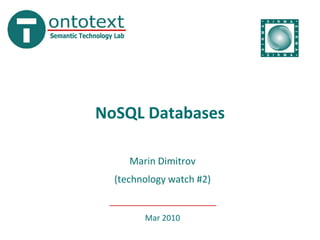
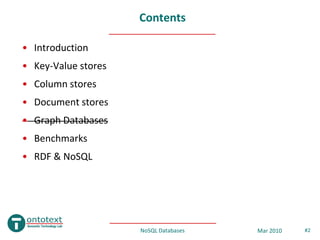
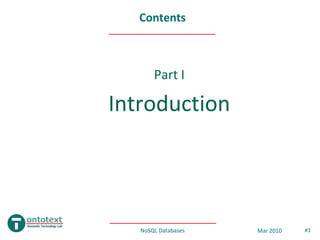
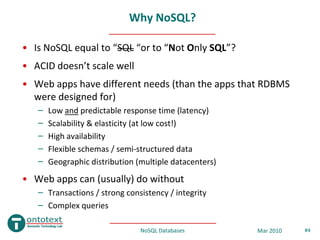
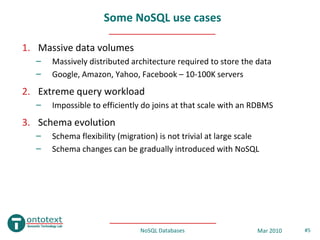
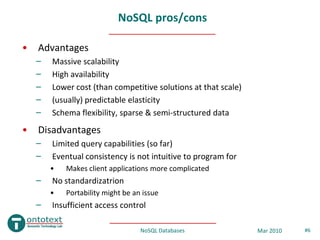
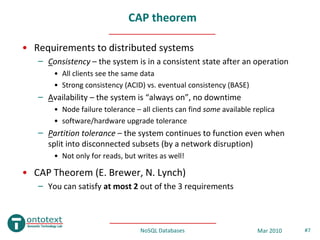
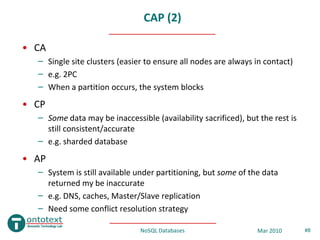
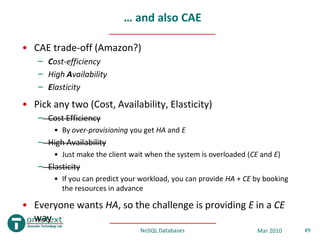
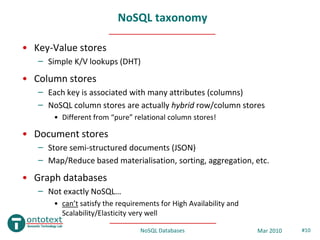
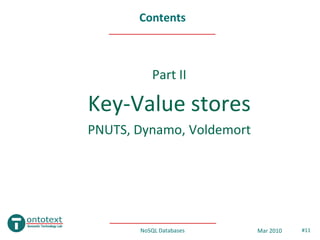
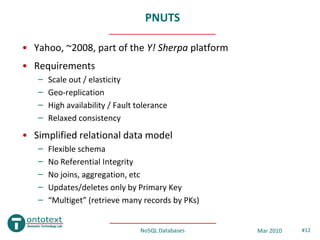
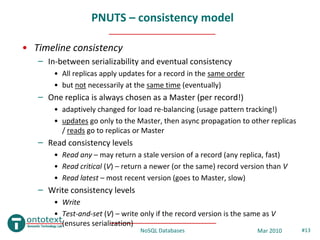
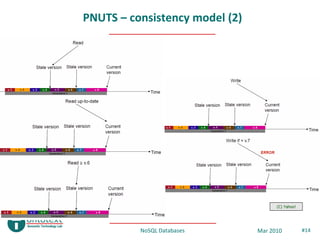
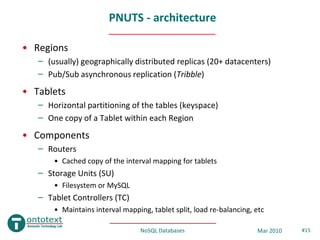
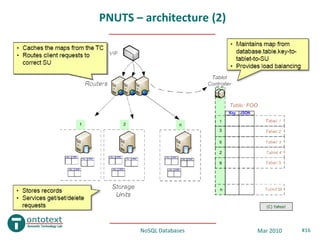
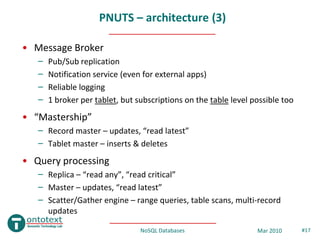
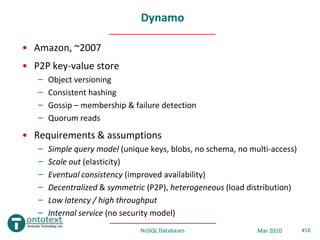
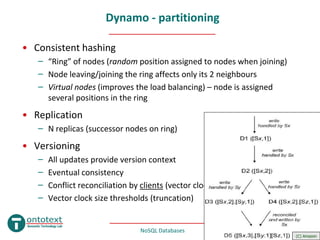
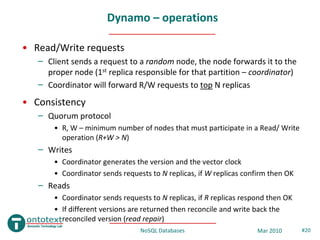
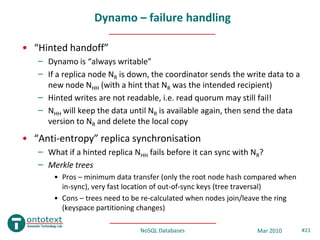
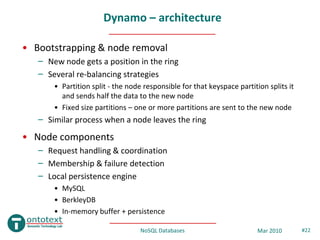
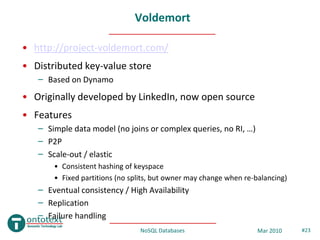
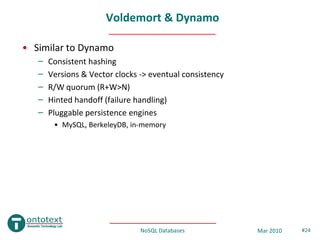
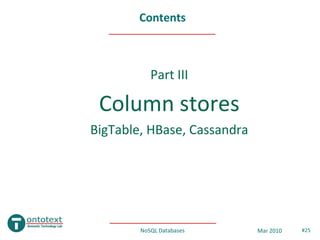

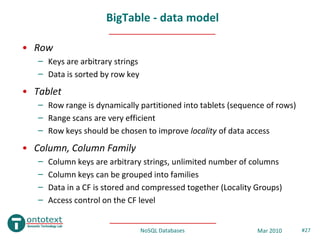
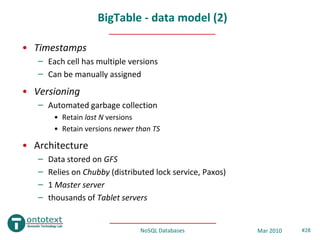
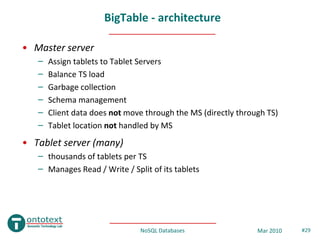
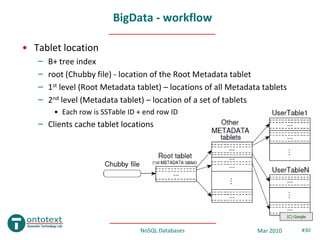
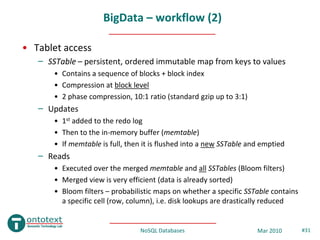

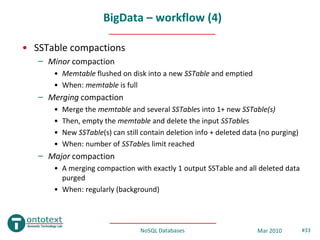

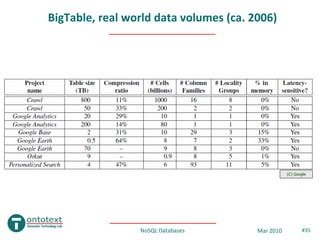
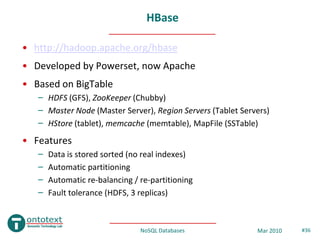

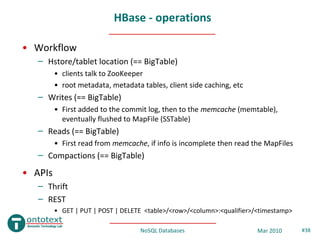

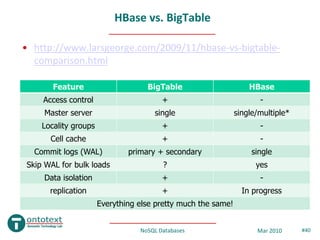
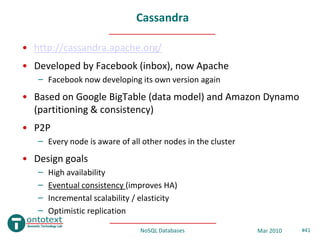

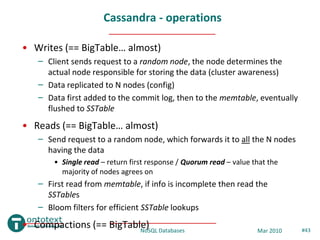
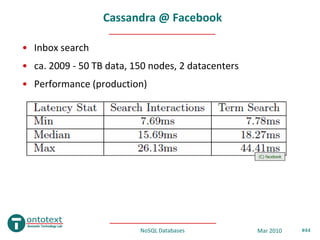
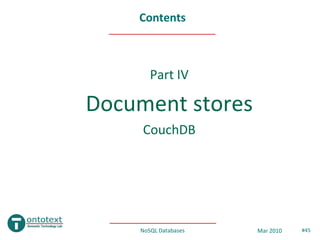
![CouchDB
• http://couchdb.apache.org/ , ~2005
• Schema-free, document oriented database
– Documents stored in JSON format (XML in old versions)
– B-tree storage engine
– MVCC model, no locking
– no joins, no PK/FK (UUIDs are auto assigned)
– Implemented in Erlang
• 1st version in C++, 2nd in Erlang and 500 times more scalable (source:
“Erlang Programming” by Cesarini & Thompson)
– Replication (incremental)
{
• Documents “name”: “Ontotext”,
“url”: “www.ontotext.com”
– UUID, version “employees”: 40
– Old versions retained “products”: [“OWLIM”, “KIM”, “LifeSKIM”, “JOCI”]
}
NoSQL Databases Mar 2010 #46](https://image.slidesharecdn.com/techwatch-nosql-100329073709-phpapp01/85/NoSQL-databases-46-320.jpg)
